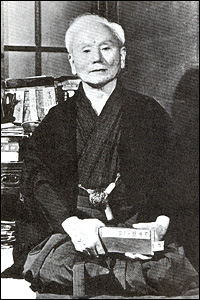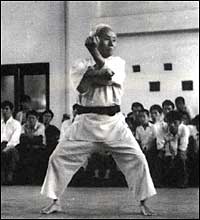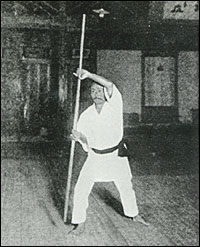Gichin Funakoshi (1868 – 1957)
 Gichin Funakoshi
Gichin Funakoshi public performance of karate
public performance of karateabout in 1950

Today, karate is a martial art practiced not only in Japan but all over the world. Before Gichin Funakoshi, karate was only a regional art of Okinawa (tei and later toudei) and was transmitted from masters to their followers personally.
Gichin learned karate under the direction of Masters Azato Anko and Itosu Anko over a long period of time. He also endeavored to spread karate, and became the Chairman of Okinawa Shobu-kai (Martial Art Association).
When the Yashiro Fleet visited Okinawa from the main islands of Japan, selected sailors practiced karate under the direction of Gichin. Since the art was so powerful, the Navy decided to not adopt the art.
In March 1921, when Emperor Hirohito was still the Crown Prince, he visited Okinawa en-route to a visit to Europe. Gichin Funakoshi led a public performance of karate, which was performed by selected students at the Grand Hall of Shuri Castle, in front of the Crown Prince.
The Crown Prince gave his impressions as “karate is so miraculous”.
In May 1922, Gichin attended the First Budo and Physical Education Exhibition sponsored by the Ministry of Education at the request of School Section of Okinawa Prefectural government, and demonstrated Okinawa’s art of self defense “karate”. This was the first performance in the main islands of Japan.
Gichin demonstrated forms of karate, and explained the forms using three figures.
After the exhibition, he gave lectures and demonstrations of karate at various places to meet with the demands of Kodo-kan, legal circles, junior high schools, Pupura Club, etc.
He did not return to Okinawa but stayed in Tokyo to spread karate-do under the name of “Karate Kenkyukai”, giving lessons in various universities and to the police.
In 1924, he changed the name “![]() (Chinese hands)” to ”
(Chinese hands)” to ” ![]() (empty hands) and “karate-jutsu (karate techniques)” to “karate-do (karate way)” based on the advice of Superntendent Priest E kun of Kamakura Enkakuji Temple. “empty” represents the spirit of Budo, which is self defense using no arms, and the ideology of the Wisdom Sutras.
(empty hands) and “karate-jutsu (karate techniques)” to “karate-do (karate way)” based on the advice of Superntendent Priest E kun of Kamakura Enkakuji Temple. “empty” represents the spirit of Budo, which is self defense using no arms, and the ideology of the Wisdom Sutras.
At this point, the Okinawan art of “karate-jutsu” was uplifted to encompass spiritual discipline.
Gichin wrote the twenty lessons of karate to show the attitudes that people must have to learn karate and the philosophy of life for karate trainees.
In 1936, Gichin changed the name “Dai-nihon Karate-do Kenkyukai”, which was established to promote communication and information exchange among people who study karate-do, to “Dai-nihon Karate-do Shoto-kai”.
“Shoto” was the pen name of Gichin.
In 1939, Gichin constructed a karate dojo “Dai-nihon Karate-do Shoto-kan” in Zoshigaya, Mejiro, with the co-operation of Gigo Funakoshi and other followers.
Shoto-kan played the central role in the technical aspects as the main dojo of Dai-nihon Karate-do Shoto-kai, and established the systematic daily exercises, which are generally practiced today.
Gichin invented Taikyoku no kata, kumite ten-no kata, and kon no kata “matsukaze”.
Until he passed away in 1957, Gichin endeavored to spread knowledge of karate-do as the Chairman of Nihon Karate-do Shoto-kai.
Gichin Funakoshi is thus called the Father of modern karate-do.
